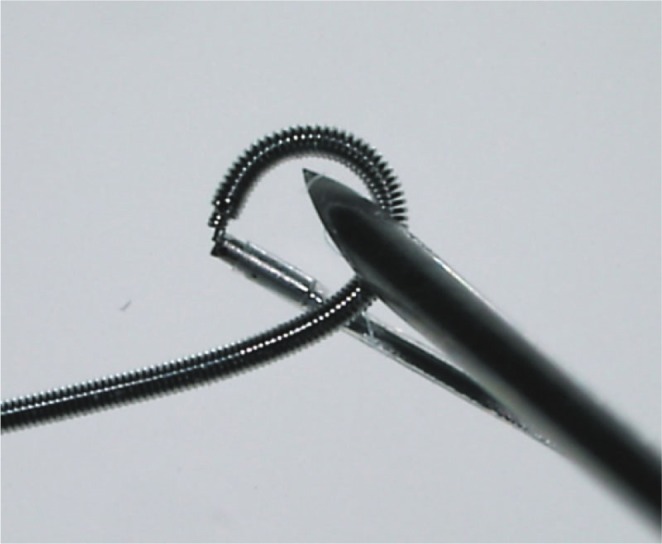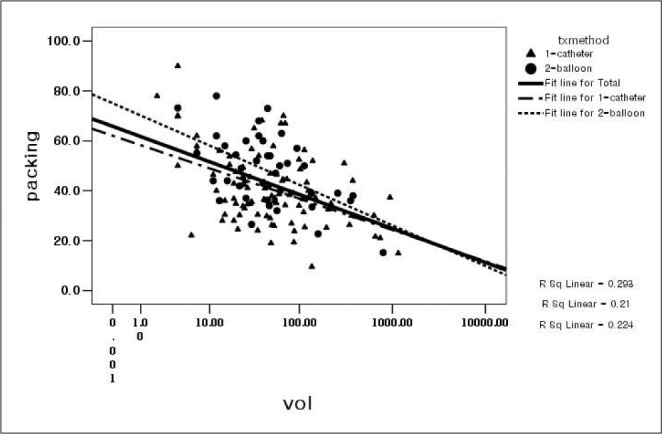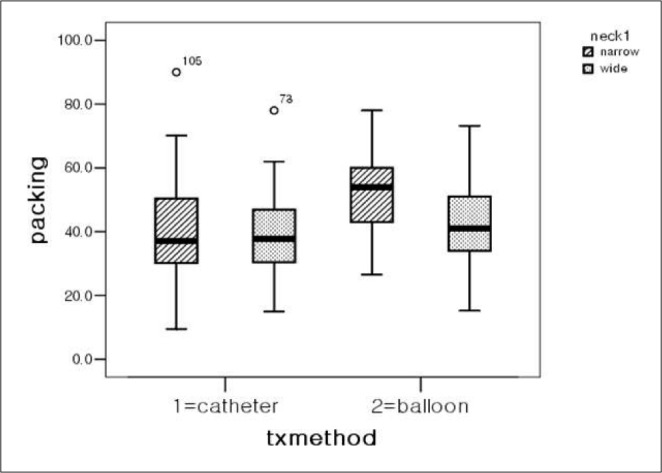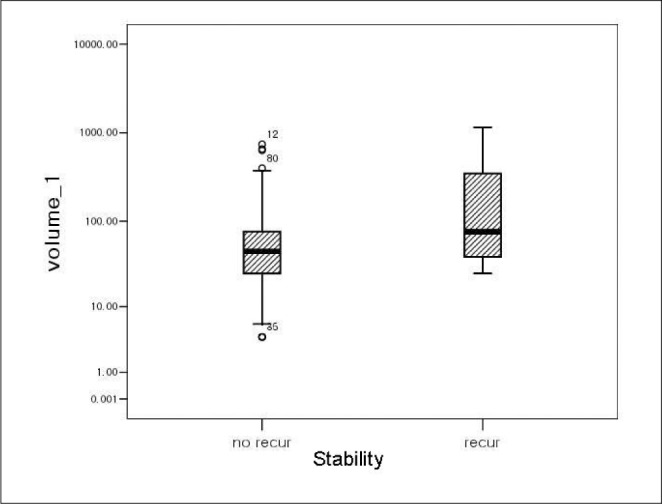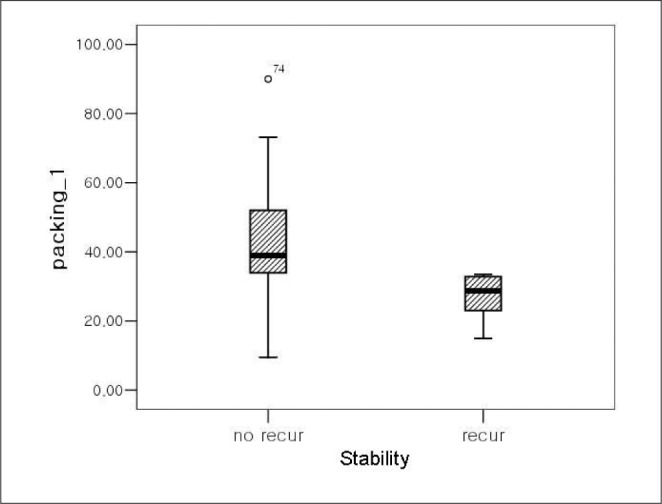Neurointervention.
2012 Sep;7(2):85-92. 10.5469/neuroint.2012.7.2.85.
Endovascular Embolization of Intracranial Aneurysms Using Bare Platinum Axium(TM) Detachable Coils: Immediate and Short-Term Follow-up Results from a Multicenter Registry
- Affiliations
-
- 1Department of Radiology, Severance Hospital, College of Medicine, Yonsei University, Seoul, Korea. dikim@yuhs.ac
- 2Department of Radiology, Samsung Medical Center, School of Medicine, Sungkyunkwan University, Seoul, Korea.
- 3Department of Radiology, Il San Hospital, Goyang, Korea.
- 4Department of Radiology, Eulji University Hospital, Daejeon, Korea.
- 5Department of Radiology, Wonju Christian Hospital, Wonju College of Medicine, Yonsei University, Wonju, Korea.
- 6Department of Radiology, Pusan National University Hospital, Pusan, Korea.
- 7Department of Radiology, Chung-Ang University Hospital, Seoul, Korea.
- KMID: 1841094
- DOI: http://doi.org/10.5469/neuroint.2012.7.2.85
Abstract
- PURPOSE
Axium(TM) coils were developed to improve the durability of coil-embolized cerebral aneurysms by increasing packing density. The purpose of this prospective multicenter registry was to evaluate the safety and durability of Axium(TM) coils.
MATERIALS AND METHODS
One hundred twenty-six patients with 135 aneurysms of < or = 15 mm in size underwent coil embolization using bare platinum coils, with Axium(TM) coils constituting over 50% of the total coil length. Immediate and short-term follow-up results were prospectively registered and retrospectively evaluated.
RESULTS
Of the 135 aneurysms (83 unruptured and 52 ruptured), immediate post-embolization angiography revealed complete occlusion in 80 aneurysms (59.3%), neck remnants in 47 (34.8%), and incomplete occlusion in 8 (5.9%). The mean packing density was 42.8% (range, 9.5 - 90%) with Axium(TM) coil length constituting a mean of 87.9% of total coil length. The rate of procedure-related complications was 16.3%. Procedure-related permanent morbidity and mortality rates were 3.2% and 0.8%, respectively. Follow-up catheter or MR angiography, which was available in 101 aneurysms at 6 - 15 months (mean, 7.7 months), revealed stable or improved occlusion in 95 aneurysms and worsening in 6 aneurysms (5.9%). Lower packing density (< 30%) remained the only predictor for anatomical worsening on multivariable logistic regression analysis (P < 0.05).
CONCLUSION
In this registry, Axium(TM) coils showed a relatively low rate of anatomical worsening on short-term follow-up imaging with an acceptable periprocedural safety profile compared to reports of other platinum coils. These results may warrant further study of long-term durability with Axium(TM) coils in larger populations.
Keyword
MeSH Terms
Figure
Reference
-
1. Ishii A, Murayama Y, Nien YL, Yuki I, Adapon PH, Kim R, et al. Immediate and midterm outcomes of patients with cerebral aneurysms treated with Matrix1 and Matrix2 coils: a comparative analysis based on a single-center experience in 250 consecutive cases. Neurosurgery. 2008; 63:1071–1079. PMID: 19008767.2. Niimi Y, Song J, Madrid M, Berenstein A. Endovascular treatment of intracranial aneurysms using Matrix coils. Early experience and midterm follow-up. Stroke. 2006; 37:1028–1032. PMID: 16514098.3. Cloft HJ. HEAL investigators. HydroCoil for endovascular aneurysm occlusion (HEAL) study: 3-6 months angiographic follow-up results. AJNR Am J Neuroradiol. 2007; 28:152–154. PMID: 17213446.4. van Rooij WJ, de Gast AN, Sluzewski M. Results of 101 aneurysms treated with polyglycolic/polylactic acid microfilament Nexus coils compared with historical controls treated with standard coils. AJNR Am J Neuroradiol. 2008; 29:991–996. PMID: 18310232.
Article5. Ferns SP, Sprengers ME, van Rooij WJ, Rinkel GJ, van Rijn JC, Bipat S, et al. Coiling of intracranial aneurysms; a systematic review on initial occlusion and reopening and retreatment rates. Stroke. 2009; 40:e523–e529. PMID: 19520984.6. Slob MJ, Sluzewski M, van Rooij WJ. The relation between packing and reopening in coiled intracranial aneurysms: a prospective study. Neuroradiology. 2005; 47:942–945. PMID: 16136261.
Article7. Sluzewski M, van Rooij WJ, Slob MJ, Bescos JO, Slump CH, Wijnalda D. Relation between aneurysm volume, packing, and compaction in 145 cerebral aneurysms treated with coils. Radiology. 2004; 231:653–658. PMID: 15118115.
Article8. Tamatani S, Ito Y, Abe H, Koike T, Takeuchi S, Tanaka R. Evaluation of the stability of aneurysms after embolization using detachable coils: correlation between stability of aneurysms and embolized volume of aneurysms. AJNR Am J Neuroradiol. 2002; 23:762–767. PMID: 12006273.9. Roy D, Milot G, Raymond J. Endovascular treatment of unruptured aneurysms. Stroke. 2001; 32:1998–2004. PMID: 11546888.
Article10. Slob MJ, van Rooij WJ, Sluzewski M. Coil thickness and packing of cerebral aneurysms: a comparative study of two types of coils. AJNR Am J Neuroradiol. 2004; 26:901–903. PMID: 15814941.
- Full Text Links
- Actions
-
Cited
- CITED
-
- Close
- Share
- Similar articles
-
- Mid-term Outcomes Comparison of Intracranial Aneurysms Treated with Polyglycolic Acid/Lactide Copolymer-Coated Coils Versus Bare Platinum Coils
- Endovascular Treatment of Cerebral Aneurysms: Detachable Coils and General Principles
- In Vitro Observation of Air Bubbles during Delivery of Various Detachable Aneurysm Embolization Coils
- Comprehension of Two Modalities: Endovascular Coiling and Microsurgical Clipping in Treatment of Intracranial Aneurysms
- Effect of Aneurysm Embolization with Autologous Fibroblast-Attached Platinum Coils

